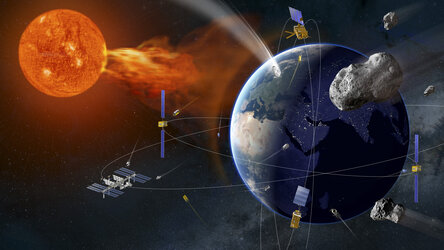Project NanoSat: Design put to the test
The project carried out a feasibility assessment of how the modular nano-satellite concept would work in practice by using ESA’s Concurrent Design Facility (CDF), a state-of-the-art facility equipped with networked computers, multimedia devices and software tools allowing expert collaboration on a real time basis.
“Some of the things that we thought might be blockers turned out not to be issues,” explained Mr Airey.
“For instance, with a compact antenna and low output power we thought downlinking sufficient data would be a problem, but the communication experts here in ESTEC, together with a team from ESOC - ESA’s spacecraft operations centre – had various techniques to make up for this. A big ground antenna could be coupled with a very large onboard data storage capability, working on a ‘store and dump’ basis. "This actually worked out to be a much cheaper way to get the data from the spacecraft and completely removed the restrictions we thought we would encounter.

“Mass memory storage could be maximised using modern off-the-shelf parts with a lot of redundancy to make up for radiation damage – maybe six times as much as we needed. Even after replacing damaged areas we’d still end up with tens of gigabytes of memory.
“Power was similarly not the problem we thought, with solar power producing 30 watts per panel – if designers need more they can simply extend extra panels onto their satellite – the panel design already allows for this in its modularity.”
And the simplest propulsion system, cold gas thrusters, was shown to deliver sufficient ‘delta-v’ for satellite manoeuvres, with higher efficiency systems such as bipropellants or ion propulsion being options for the future.
Putting NanoSats to work
Still to be defined in detail is the kind of payloads NanoSats might carry, and the work they could be put to. The project aims to solicit views from industry – the project’s progress was presented at ESA’s Avionics Data, Control and Software Systems (ADCSS) workshop in October 2009 – but is still to be presented to the scientific community.
“We would like to work with the scientific community in a different way with this platform but are still examining how we could do that in practice,” said Mr Airey. “Generally the science community outline what they want and the Agency finds a way to make it happen and a full-scale mission takes place. What we’re aiming to ask is ‘here is this capability, what use could you make of it?’”

One promising novel approach that would become feasible with this concept would be to operate multiple NanoSats together.
For example, a single standard module could house a 10-30 metre resolution imager for Earth observation, providing medium-resolution services such as land use monitoring. But launch 50 of them together and the user gains an unprecedented ability to revisit any part of the planet within a matter of minutes, leading to near-real-time Google Earth type applications.
Or NanoSats could be flown in a constellation for ‘aperture synthesis’ – where multiple observations are combined together to deliver an image resolution equivalent to a single, giant telescope. Light-based observations are out due to the extreme navigational precision required, but aperture synthesis is feasible at longer wavelengths and especially attractive for radio telescope applications.
“To make them really cheap and gain synergies we’ll need to manufacture a lot of parts,” Mr Airey concludes. “So it makes sense to think of ways to make use of many NanoSats, alone or in combination. It is a ‘chicken and egg’ type situation though – cheap capable NanoSats enable many distributed sensing missions but you also need these missions to enable cheap capable NanoSats!”
Returning to one of the project’s inspirations, dialogue with the CubeSat community is being arranged through ESA’s Education Office to seek out ideas for aiding the NanoSat development, CubeSats could be used, for example, as a way of rapidly testing components at low cost. Industry is also being consulted on this promising project’s next steps.















 Germany
Germany
 Austria
Austria
 Belgium
Belgium
 Denmark
Denmark
 Spain
Spain
 Estonia
Estonia
 Finland
Finland
 France
France
 Greece
Greece
 Hungary
Hungary
 Ireland
Ireland
 Italy
Italy
 Luxembourg
Luxembourg
 Norway
Norway
 The Netherlands
The Netherlands
 Poland
Poland
 Portugal
Portugal
 Czechia
Czechia
 Romania
Romania
 United Kingdom
United Kingdom
 Slovenia
Slovenia
 Sweden
Sweden
 Switzerland
Switzerland




























